Spoons with elaborate bowl displays of berries or fruits are referred to generically as "berry spoons", even though they almost inevitably show displays of fruits. But who am I to argue with word usage that goes back 175 years?
Most of these spoons are very large, so I have included a U.S. quarter in the picture so that you can judge relative size. Simply hold a quarter up to the screen. If the pictured quarter is smaller, then you know that the spoon is much larger than pictured.
This ladle has English hallmarks dating it to London, 1800-01. Most likely the ladle was originally made with a plain bowl and then was later "re-decorated" in the Victorian style. This was a very common occurrence. Many silver purists decry this practice and claim that it ruins the clean lines of the original piece. Possibly they are correct, but I personally enjoy the later Victorian decoration much more than the smooth lines of the original piece. Opinion is divided on this issue and prices usually reflect this dichotomy. The repousse work and engraving in the bowl is quite nice, but the bowl is very deep, and the angle of the camera doesn't show all of the fine detail.
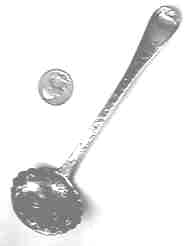
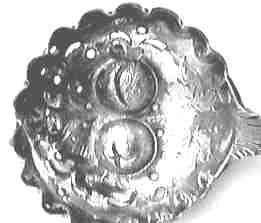

Old English style berry spoon. The hallmarks date this spoon to London, 1813 which is when it was made. But the bowl and handle decorations were probably added during the middle Victorian era. This spoon measures almost 9" (230mm).
This piece has markings which are very difficult to decipher, but I suspect that they are French. This could be a later re-decorated piece, or one made entirely in this style.
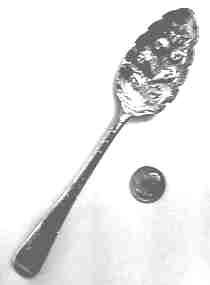
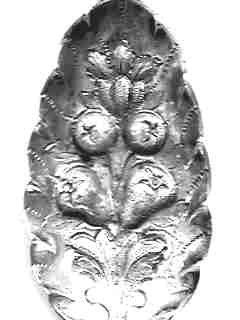
This pair of berry spoons were made ca. 1860. They show very desirable skilled silver workmanship including extensive repousse and chasing.
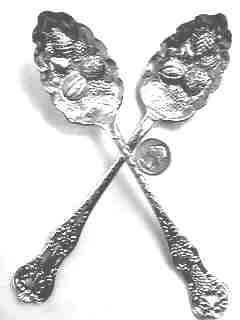
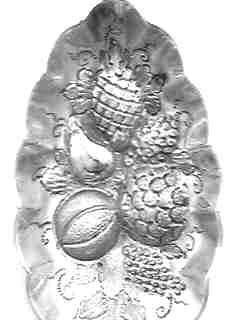
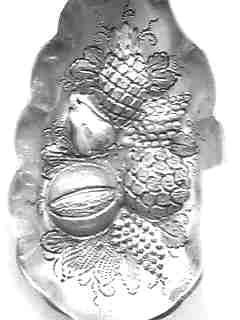
This spoon is made by Kirk Silversmiths and is probably late Victorian (1890's). It is a combined product of the machine and a silversmith. The handle is machine produced and the basic design of the bowl is machine produced, but the bowl detail work has been "touched up" by hand. It is also much smaller physically than the other pieces shown on this page.

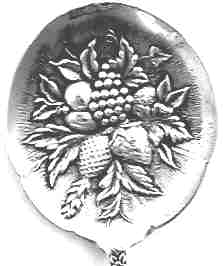

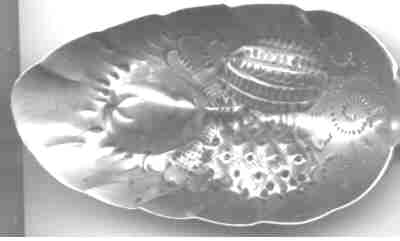
American made Berry spoon in the style of the European spoons. This large server spoon was made by Wm. Gale Jr. of New York ca. 1860. The senior Wm. Gale invented the roller die for making pattern flatware. During the 14 year exclusive patent control, this firm became the largest manufacturer of spoons in the USA. Eventually the drop hammer was perfected and progress exacted its toll on this firm. The bowl on this spoon was decorated by hand in the same manner as the European spoons..


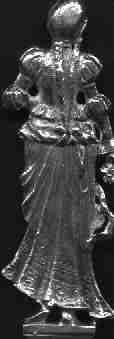
This very large (9.125" 232mm) and impressive Dutch fruit spoon features a large cast finial of a Dutch flower girl and a cast bowl (below) in the typical "English Victorian Style". The spoon also has English import marks dating it to 1895. I thought that her hair style in the back was interesting.
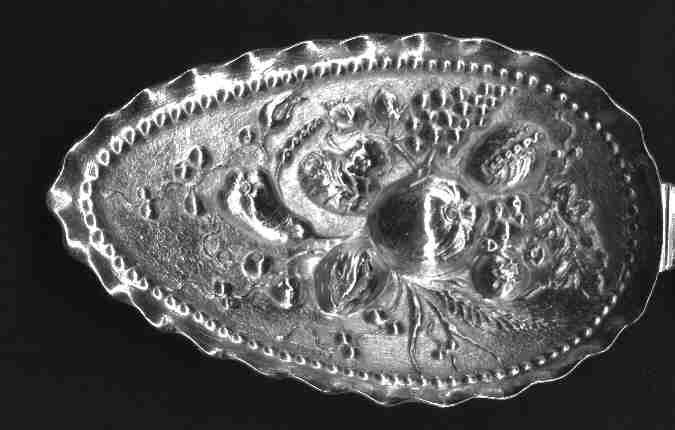

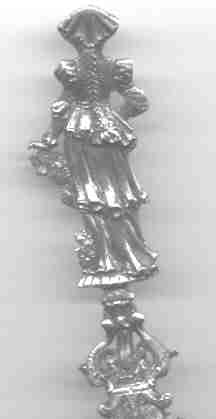
This spoon is similar to the above, but it is slightly smaller only measuring 7.8". The figures and bowls are different. The design on this spoon is quite intriguing. With her right hand she is holding a ring. Attached to the ring appears to be a lock. I am not sure if this is a representation of a purse, or if it is a chastity belt lock. hmm! Also the base she is standing on is actually twin porpoises.
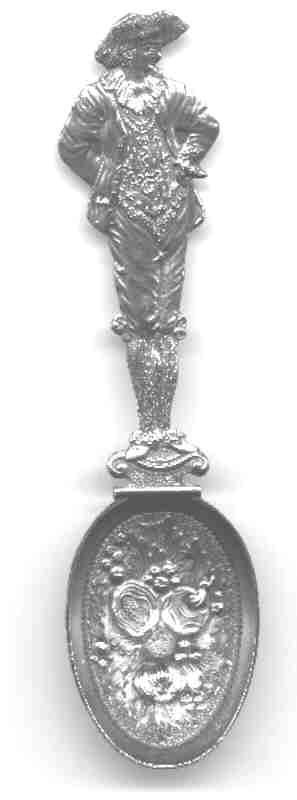

European nobleman (dandy?) dressed in very fancy suit (see front and back -right picture). This entire spoon is hand chased with incredible attention to detail. The bowl is very deep and has a beautiful fruit display. The spoon is marked with a very unusual hidden (made to look like part of the fruit design) mark which I haven't yet traced. Measures about 7.7"
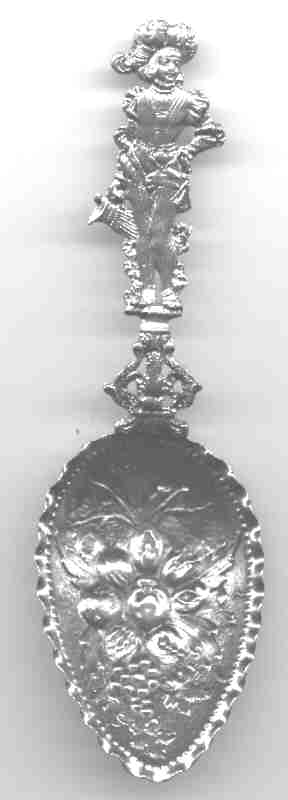
A gentleman dressed in a very fancy outfit. His right hand is holding a large beer tanquard and his left hand is on his hip. Detailed on both sides of the handle and an intricate fruit display in the bowl. The man is standing on a pedestal of twin porpoises. measures about 7.8"
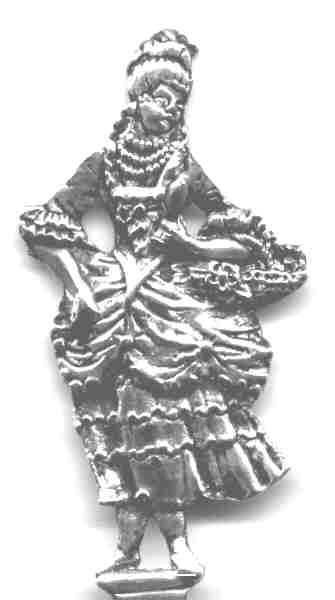
Large (6.7") fruit/berry server with a Victorian era lady carrying a basket.
This spoon is marked "sterling 2" and there are no other marks to help us
determine its source so I am assuming that it was made in the USA or made
for the American market. It is not really made in the same style as the European
pieces and the quality of the workmanship while reasonable is not as good
as I would like to see, so I suspect that it was made in imitation of the
European pieces. The three strands of pearls around her neck and the dress
style with the tight corset tell us that it was most likely made in the 1890's.
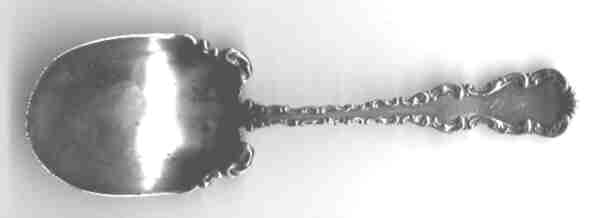
Most of the berry spoons produced in this country are basically large bowls with flatware style handles. This piece by Whiting in the Louis XV pattern measures about 8.25" (210mm) was patented in 1891 and is very typical of the output of the major silver factories.
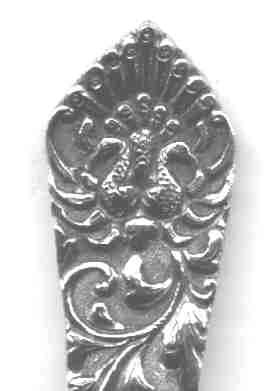
note the nice peacocks and see story below
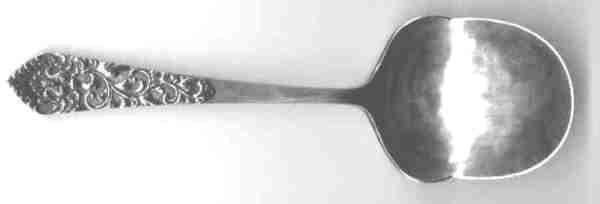
This berry spoon is an interesting example of spoons made in the Orient for Europeans. When Europeans traveled to the Oriental countries, they planned to stay for a long time, so they usually took their silver and other valuables. Silver was of lesser value in the Orient and the silversmiths worked very cheaply. The wealthy Europeans would take a piece to a silversmith and tell them to reproduce it. The Oriental silversmiths would then prepare an exact copy including a hand made mark which matched the original stamped mark. This spoon appears to be of Dutch descent, but based upon the story the vendor gave me and my own experience, I believe it was produced in one of the Oriental countries. I suspect that it might be Indonesia, because the wealthy Dutch oil men were stationed there, but it could have been China or one of the other south east Asian areas. This very heavy hand made silver spoon measures just under 9" (230mm) and was probably produced in the 1880 - 1900 time period from a design of the 1870-1880 time period.
Click to see a Gorgeous set of Berry spoons with gold nuggets